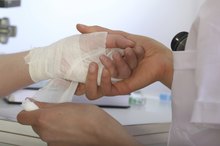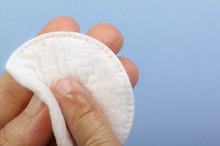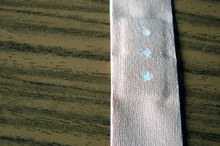What does fact checked mean?
At Healthfully, we strive to deliver objective content that is accurate and up-to-date. Our team periodically reviews articles in order to ensure content quality. The sources cited below consist of evidence from peer-reviewed journals, prominent medical organizations, academic associations, and government data.
The information contained on this site is for informational purposes only, and should not be used as a substitute for the advice of a professional health care provider. Please check with the appropriate physician regarding health questions and concerns. Although we strive to deliver accurate and up-to-date information, no guarantee to that effect is made.
How Do I Treat a Grease Burn?
Burns caused by hot grease are second-degree burns and require proper care to prevent infection or scarring 1. Depending on the severity of the grease burn, different methods of treatment are recommended. As always, if you have questions or concerns, contact a medical professional for assistance.
For A Grease Burn Without Open Blisters
Take care not to pop the blisters, as this is your body's way of protecting itself from infection. The skin around the burn will begin to swell so remove any tight-fitting clothing or jewelry that is near the burn. To help treat the pain, hold the burned area under cool running water or apply a towel or washcloth that has been moistened with cold water. Continue doing so until the pain has subsided. Don't use ice or ice water.
Cover the burned area with a sterile, dry bandage (such as a gauze pad) and avoid applying tape to the burned area. Also, avoid using ointments, petroleum jelly, or other home remedies on the burn, as these trap in the heat and will increase the severity of the burn. If the burn is on an extremity, keep that area elevated to combat swelling.
- Take care not to pop the blisters, as this is your body's way of protecting itself from infection.
- Also, avoid using ointments, petroleum jelly, or other home remedies on the burn, as these trap in the heat and will increase the severity of the burn.
For A Grease Burn With Open Blisters
How to Treat a Burn Bubble
Learn More
Unlike a burn without open blisters, you should not run cool water over the burn. Also, if there is any clothing that is stuck to the burn, don't remove it. You may, however, apply a sterile, dry bandage (such as a gauze pad), again avoiding the application of tape to the burn.
When To See A Doctor
If the burned area is larger than 2 to 3 inches in diameter, or if the burned area is on the face, hands, penis, vaginal area, buttocks or over a joint, you should seek medical attention. Also, whether the initial burn was treated by a doctor or not, you should seek medical attention if you develop a fever, pus, green or brown fluid from the burn, increased redness, increased swelling or numb or cool skin beyond the area of the burn. You should also see a doctor for a burn that takes more than 2 weeks to heal. These may be signs of an infection and will need immediate treatment.
- If the burned area is larger than 2 to 3 inches in diameter, or if the burned area is on the face, hands, penis, vaginal area, buttocks or over a joint, you should seek medical attention.
- Also, whether the initial burn was treated by a doctor or not, you should seek medical attention if you develop a fever, pus, green or brown fluid from the burn, increased redness, increased swelling or numb or cool skin beyond the area of the burn.
Proper Burn Care
How to Treat Rug Burn
Learn More
It is very important that you give proper attention to your burn in order to prevent infection. Before changing a bandage, be sure to wash your hands with soap and water. Have the new bandage sitting ready on a sterile area such as a towel. Use care when removing the old bandage and soak it to assist in removing if it is sticking to the burn. Very gently wash the burned area and examine it for any changes indicative of infection like pus, swelling and redness. Spread a thin layer of an antibiotic cream over the burn then carefully dress the burn with the clean bandage.
- It is very important that you give proper attention to your burn in order to prevent infection.
- Use care when removing the old bandage and soak it to assist in removing if it is sticking to the burn.
Related Articles
References
- Mayo Clinic: Burns
- Cuttle L, Pearn J, McMillan JR, Kimble RM. A review of first aid treatments for burn injuries. Burns. 2009;35(6):768-775. doi:10.1016/j.burns.2008.10.011
- Lloyd ECO, Rodgers BC, Michener M, Williams MS. Outpatient burns: prevention and care. Am Fam Physician. 2012;85(1):25-32.
- Shrivastava P, Goel A. Pre-hospital care in burn injury. Indian J Plast Surg. 2010;43(Suppl):S15-S22. doi:10.4103/0970-0358.70720
- Nielson CB, Duethman NC, Howard JM, Moncure M, Wood JG. Burns: Pathophysiology of Systemic Complications and Current Management. J Burn Care Res. 2017;38(1):e469-e481. doi:10.1097/BCR.0000000000000355
- Schaefer TJ, Tannan SC. Thermal Burns. In: StatPearls. Treasure Island, FL: StatPearls Publishing; 2019.
- Cancio LC, Barillo DJ, Kearns RD, et al. Guidelines for Burn Care Under Austere Conditions: Surgical and Nonsurgical Wound Management. J Burn Care Res. 2017;38(4):203-214. doi:10.1097/BCR.0000000000000368
- Lloyd ECO, Rodgers BC, Michener M, Williams MS. Outpatient burns: prevention and care. Am Fam Physician. 2012;85(1):25-32.
- Munteanu A, Florescu IP, Nitescu C. A modern method of treatment: The role of silver dressings in promoting healing and preventing pathological scarring in patients with burn wounds. J Med Life. 2016;9(3):306-315.
Writer Bio
Sarah Jackson has been writing freelance for almost four years, the majority of her work being featured on Adventure Journey, an online travel publication. She is currently in her final year of her M.S.W. degree at Temple University, with a B.S. degree from BYU.








